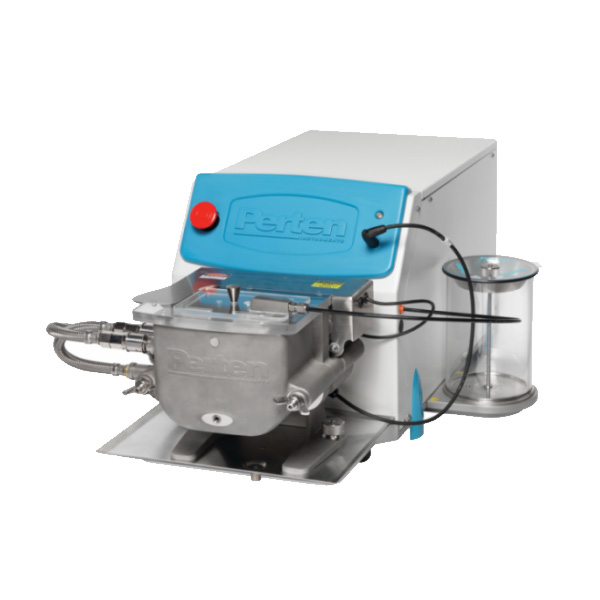doughLAB - analyze flour properties
AACCI approved analysis of flour water absorption, dough development and mixing tolerance.
The doughLAB determines water absorption of flour, dough development time and other dough mixing parameters. The instrument uses the traditional 20-minute test and the new 10-minute high-speed mixing test (AACCI 54-70.01). The 10-minute test increases lab throughput and efficiency. It improves analysis results by making it easier to interpret samples with long development times, indistinct development peaks and multiple peaks. In addition, the high-speed method more closely resembles today’s bread making processes. Results are presented in FU or SI units.
Features and benefits
Approved high-speed rapid mixing method
Fast 10-minute high energy mixing AACCI Method 54-70.01.
Versatile
Choice of the traditional 20-minute test, new 10-minute high-speed mixing test, and user-defined methods. Bake labs can create specific tests to study flour performance using variable temperature and high speed/energy mixing. The programmable temperature to study dough performance during heating, cooling and gelling/cooking. Variable speed mixing to study stiff and crumbly dough, novel formulations, evaluate dough response to changing stress and mimic commercial mixing.
Automated
Integrated bowl temperature control system. Integrated, automatic water dispensing with “drip” function for repeatable, operator-independent measurement of water absorption.
User-Friendly
Windows software with flour/dough quality methods included in the software library, plus the user can create their own methods. Real-time graphs, data analysis, and diagnostics. Test configuration, data and analysis programs stored in software and easily transferable. Easy to use “routine user” mode.
Traceable
Calibrated in standard and traceable toque units (Nm). Complies with ISO9000 and Quality System requirements.
Secure results
Software password protection and single-page report with traceable data comply with Electronic Registration/Electronic Signature requirements.
Easy Clean-Up
Bowl disassembles quickly for easy cleaning to increase sample throughput.
Virtual Blending
Millers can quickly calculate flour blends to meet target water absorption specifications using the software. Perform complex “what if” analyses without having to run lots of tests. These blend models can be used to manage crop changeover issues and design flour blends to maintain specifications for specific purposes and products while reducing costs.
Operation and handling
The doughLAB is a conventional sigma arm dough mixer which measures water absorption (WA) and dough mixing parameters. The doughLAB incorporates programmable mixing speed and temperature, integrated water dispensing, Windows software to control both testing and analysis, and traceable calibration.
|
|
|
|
|
Open the appropriate doughLAB method in DLW software and enter sample information. Accurately weigh the amount of flour calculated for you. |
Open the lid of the mixing bowl and dispense the flour into the bowl. |
Close the safety lid. Place the water dispensing head in the bowl lid. Start the test. |
|
|
|
|
|
If necessary scrape down the sides of the bowl carefully to integrate the dough, using the plastic spatula provided. |
Secure the evaporation shield to minimize evaporation of water. |
The resistance of the dough will be graphed on the monitor. |
Applications
Wheat flour doughs are nonlinear viscoelastic materials, and as such, there is a complicated relationship between the strains imparted during mixing (stretching, shearing, compression, and relaxation) and dough resistance. A number of factors related to processing conditions and flour type will also have a large effect on how the dough behaves. Variations in water and protein content, changes in the fibrillar structure of the protein, starch, starch damage, pentosans, gluten strength and the actions of enzymes on the dough components all affect dough behavior. Due to the complex nature of dough behavior, an empirical instrument test is desirable.
The two key pieces of information required by millers and bakers are the absorption (amount of water required for the dough to reach a definite consistency) and the mixing profile of the dough (development time, stability and softening) which are indicative of the suitability of the flour for different applications. Other parameters may also be measured.
doughLAB information will be useful to:
- Milling, baking (bread, cake, pastry, biscuit), pasta and Asian products (eg steam bread, noodles, and flatbread) laboratories who need to test wheat flour quality and processing characteristics.
- Specific applications include the study of gluten and carbohydrate functionality, enzyme activities in flour, functions and effects of dough ingredients (dried dairy ingredients, organic acids, salt, emulsifiers, antioxidants, yeast , sugar, improvers and enzymes), properties of composite flours, effects of special flour treatments and emulation of commercial processes.
- There are also applications for the testing of cereal grains other than wheat such as rye, triticale, and durum. doughLAB can be used to study the mixing characteristics of vital gluten which is added when the flour has insufficient quantity or quality of gluten and is often used in specialty bread (eg those made with rice flour), bread manufactured at high altitude and for much brown and grain bread.
Specifications
|
General |
|
|
Power Requirements: Temperature Monitoring: |
AC 220/240 V ± 10% 50/60 Hz, 1200 VA. |


